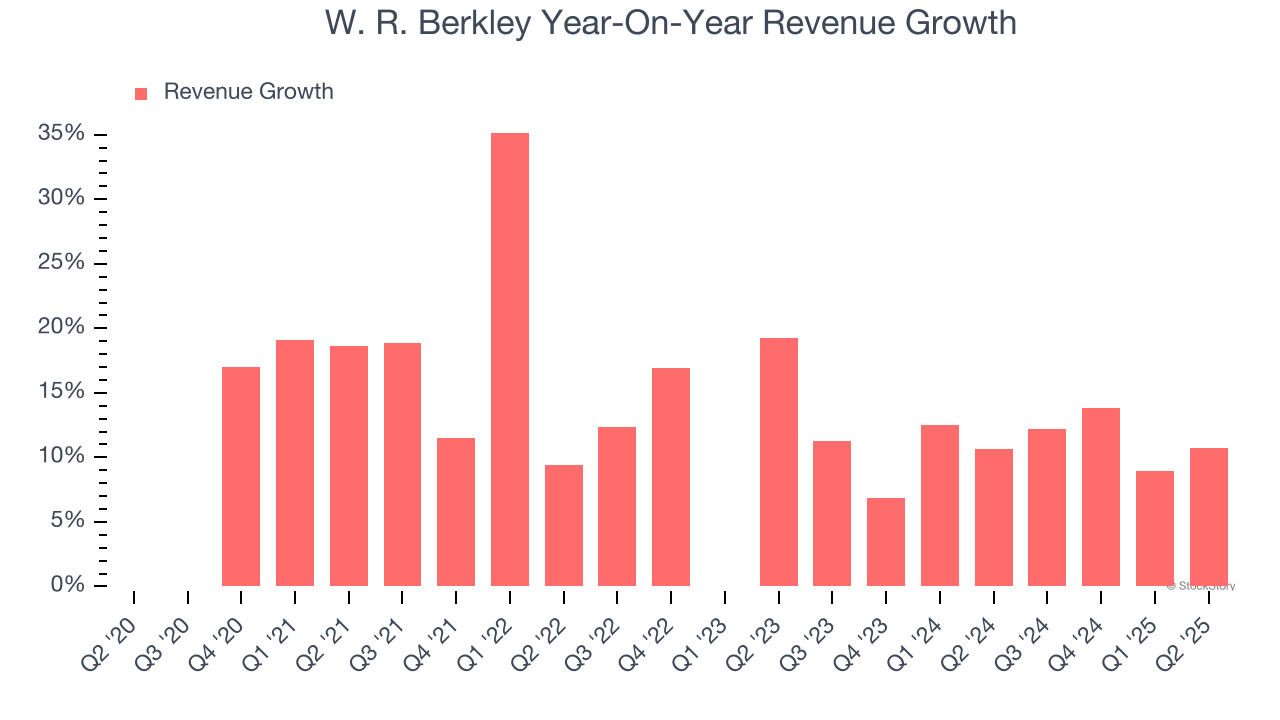
Property casualty insurer W. R. Berkley (NYSE: WRB) reported Q2 CY2025 results topping the market’s revenue expectations, with sales up 10.8% year on year to $3.67 billion. Its non-GAAP profit of $1.05 per share was 2.5% above analysts’ consensus estimates.
Is now the time to buy W. R. Berkley? Find out by accessing our full research report, it’s free.
W. R. Berkley (WRB) Q2 CY2025 Highlights:
- Net Premiums Earned: $3.10 billion vs analyst estimates of $3.10 billion (8.8% year-on-year growth, in line)
- Revenue: $3.67 billion vs analyst estimates of $3.63 billion (10.8% year-on-year growth, 1% beat)
- Combined Ratio: 91.6% vs analyst estimates of 91.2% (in line)
- Adjusted EPS: $1.05 vs analyst estimates of $1.02 (2.5% beat)
- Market Capitalization: $26.08 billion
Company Overview
Founded in 1967 and operating through more than 50 specialized insurance units across the globe, W. R. Berkley (NYSE: WRB) underwrites commercial insurance and reinsurance through specialized subsidiaries serving industries from healthcare to construction to transportation.
Revenue Growth
Insurance companies earn revenue from three primary sources:
- The core insurance business itself, often called underwriting and represented in the income statement as premiums
- Income from investing the “float” (premiums collected upfront not yet paid out as claims) in assets such as fixed-income assets and equities
- Fees from various sources such as policy administration, annuities, or other value-added services
Thankfully, W. R. Berkley’s 13.2% annualized revenue growth over the last five years was excellent. Its growth surpassed the average insurance company and shows its offerings resonate with customers, a great starting point for our analysis.

We at StockStory place the most emphasis on long-term growth, but within financials, a half-decade historical view may miss recent interest rate changes, market returns, and industry trends. W. R. Berkley’s annualized revenue growth of 10.8% over the last two years is below its five-year trend, but we still think the results suggest healthy demand.  Note: Quarters not shown were determined to be outliers, impacted by outsized investment gains/losses that are not indicative of the recurring fundamentals of the business.
Note: Quarters not shown were determined to be outliers, impacted by outsized investment gains/losses that are not indicative of the recurring fundamentals of the business.
This quarter, W. R. Berkley reported year-on-year revenue growth of 10.8%, and its $3.67 billion of revenue exceeded Wall Street’s estimates by 1%.
Net premiums earned made up 85% of the company’s total revenue during the last five years, meaning W. R. Berkley barely relies on non-insurance activities to drive its overall growth.

Markets consistently prioritize net premiums earned growth over investment and fee income, recognizing its superior quality as a core indicator of the company’s underwriting success and market penetration.
Unless you’ve been living under a rock, it should be obvious by now that generative AI is going to have a huge impact on how large corporations do business. While Nvidia and AMD are trading close to all-time highs, we prefer a lesser-known (but still profitable) stock benefiting from the rise of AI. Click here to access our free report one of our favorites growth stories.
Book Value Per Share (BVPS)
Insurance companies are balance sheet businesses, collecting premiums upfront and paying out claims over time. The float–premiums collected but not yet paid out–are invested, creating an asset base supported by a liability structure. Book value per share (BVPS) captures this dynamic by measuring these assets (investment portfolio, cash, reinsurance recoverables) less liabilities (claim reserves, debt, future policy benefits). BVPS is essentially the residual value for shareholders.
We therefore consider BVPS very important to track for insurers and a metric that sheds light on business quality. While other (and more commonly known) per-share metrics like EPS can sometimes be lumpy due to reserve releases or one-time items and can be managed or skewed while still following accounting rules, BVPS reflects long-term capital growth and is harder to manipulate.
W. R. Berkley’s BVPS grew at an impressive 11.1% annual clip over the last five years. BVPS growth has also accelerated recently, growing by 17.2% annually over the last two years from $17.83 to $24.50 per share.

Over the next 12 months, Consensus estimates call for W. R. Berkley’s BVPS to grow by 23% to $26.28, elite growth rate.
Key Takeaways from W. R. Berkley’s Q2 Results
It was good to see W. R. Berkley narrowly top analysts’ revenue and EPS expectations this quarter. On the other hand, its book value per share missed. Overall, this was a mixed quarter. The stock remained flat at $67.80 immediately following the results.
The latest quarter from W. R. Berkley’s wasn’t that good. One earnings report doesn’t define a company’s quality, though, so let’s explore whether the stock is a buy at the current price. We think that the latest quarter is only one piece of the longer-term business quality puzzle. Quality, when combined with valuation, can help determine if the stock is a buy. We cover that in our actionable full research report which you can read here, it’s free.





